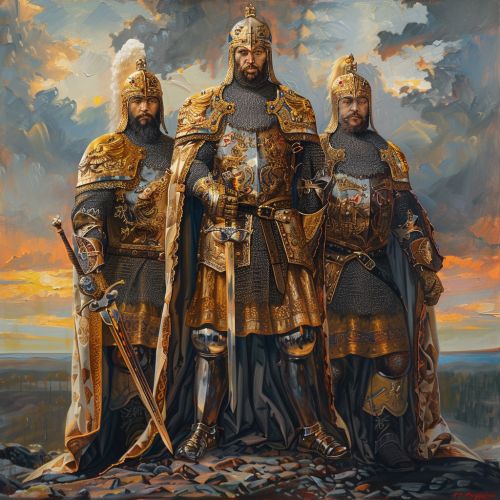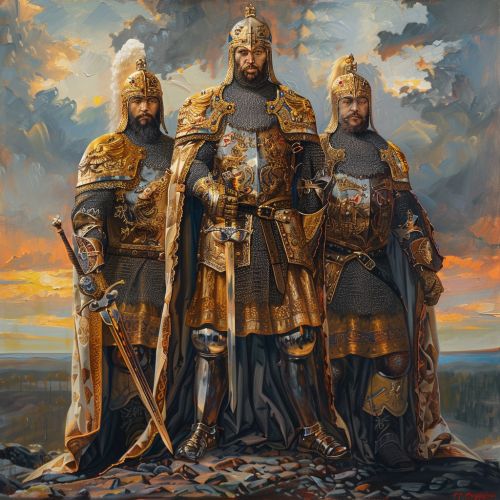Vasnetsov: Difference between revisions
(Created page with "== Early Life and Education == Viktor Mikhailovich Vasnetsov was born on May 15, 1848, in the village of Lopyal, Vyatka Governorate, Russian Empire. He was the second of six children in a family of a village priest. Vasnetsov's early education was deeply influenced by his father's scholarly pursuits, which included a strong emphasis on classical literature and religious texts. This early exposure to both religious and folk traditions would later play a significant role...") |
No edit summary |
||
| Line 17: | Line 17: | ||
One of Vasnetsov's most famous works, "The Bogatyrs" (1898), depicts three legendary knights from Russian folklore: Ilya Muromets, Dobrynya Nikitich, and Alyosha Popovich. This painting is celebrated for its intricate detail and the way it captures the heroic spirit of these mythic figures. The work is housed in the Tretyakov Gallery in Moscow. | One of Vasnetsov's most famous works, "The Bogatyrs" (1898), depicts three legendary knights from Russian folklore: Ilya Muromets, Dobrynya Nikitich, and Alyosha Popovich. This painting is celebrated for its intricate detail and the way it captures the heroic spirit of these mythic figures. The work is housed in the Tretyakov Gallery in Moscow. | ||
[[Image:Detail-97029.jpg|thumb|center|Painting of three legendary knights from Russian folklore, standing in a heroic pose.|class=only_on_mobile]] | |||
[[Image:Detail-97030.jpg|thumb|center|Painting of three legendary knights from Russian folklore, standing in a heroic pose.|class=only_on_desktop]] | |||
=== The Knight at the Crossroads === | === The Knight at the Crossroads === | ||
Latest revision as of 15:09, 16 July 2024
Early Life and Education
Viktor Mikhailovich Vasnetsov was born on May 15, 1848, in the village of Lopyal, Vyatka Governorate, Russian Empire. He was the second of six children in a family of a village priest. Vasnetsov's early education was deeply influenced by his father's scholarly pursuits, which included a strong emphasis on classical literature and religious texts. This early exposure to both religious and folk traditions would later play a significant role in shaping his artistic vision.
Artistic Training
In 1867, Vasnetsov moved to St. Petersburg to enroll in the Imperial Academy of Arts. His initial training was under the tutelage of prominent artists such as Ivan Kramskoi and Pavel Chistyakov. During this period, Vasnetsov was exposed to the Peredvizhniki movement, which advocated for realistic and socially conscious art. This exposure significantly influenced his early works, which often depicted the harsh realities of peasant life.
Transition to Mythological and Historical Themes
By the late 1870s, Vasnetsov began to shift his focus from social realism to mythological and historical subjects. This transition was marked by his move to Moscow in 1878, where he became involved with the Abramtsevo Colony, a group of artists and intellectuals dedicated to reviving traditional Russian art forms. It was here that Vasnetsov began to explore themes from Russian folklore, epic poetry, and history, which would come to define his mature style.
Major Works and Contributions
The Bogatyrs
One of Vasnetsov's most famous works, "The Bogatyrs" (1898), depicts three legendary knights from Russian folklore: Ilya Muromets, Dobrynya Nikitich, and Alyosha Popovich. This painting is celebrated for its intricate detail and the way it captures the heroic spirit of these mythic figures. The work is housed in the Tretyakov Gallery in Moscow.


The Knight at the Crossroads
Another significant work is "The Knight at the Crossroads" (1878), which portrays a solitary knight contemplating a signpost at a crossroads. This painting is often interpreted as a metaphor for the existential choices faced by individuals and nations. The use of dark, brooding colors and the knight's contemplative pose evoke a sense of melancholy and introspection.
The Tsar's Family
In addition to his mythological works, Vasnetsov also created a series of historical paintings, including "The Tsar's Family" (1884). This painting depicts the family of Tsar Ivan the Terrible and is noted for its psychological depth and historical accuracy. Vasnetsov's meticulous attention to detail in costume and setting provides a vivid portrayal of the period.
Architectural Contributions
Vasnetsov's talents were not limited to painting; he also made significant contributions to architecture. One of his most notable projects was the design of the facade for the Tretyakov Gallery in Moscow. Completed in 1904, the facade features elements of traditional Russian architecture and reflects Vasnetsov's deep appreciation for his country's artistic heritage.
Influence and Legacy
Vasnetsov's work had a profound impact on Russian art and culture. His revival of traditional Russian themes and styles helped to foster a sense of national identity during a period of significant social and political change. His influence can be seen in the works of later artists, including Mikhail Nesterov and Ivan Bilibin, who also drew inspiration from Russian folklore and history.
